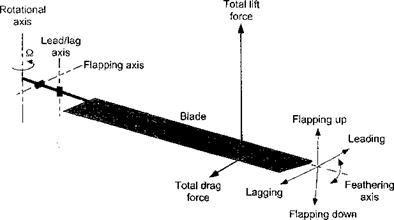Rotating Blade Motion
It is sufficient to say that it [the dissymmetry of lift on the rotor] is completely eliminated by the articulation of the rotor blades, which no longer set up a powerful inherent force which must be overcome in order to control the craft.
Juan de la Cierva (1931)
4.1 Introduction
The interdependent coupling of the aerodynamic forces produced on the rotor blades and the resulting blade motion is the key to understanding the behavior of the blade response and in developing a means of giving the pilot positive control over the rotor system. A distinctive feature of helicopter rotors is that articulation in the form of flapping and lead-lag hinges is incorporated at the root of each blade. These may be mechanical hinges, or modem rotor hub designs may use semi-rigid or hingeless flexures that allow motion about a “virtual” hinge location. In either case, the hinges allow each blade to independently flap and lead or lag with respect to the hub plane under the action of varying aerodynamic lift and drag loads (Fig. 4.1). The idea of a flapping hinge for a rotor was first patented by Bartha & Madzer (1913). However, the flapping hinge was first successfully used on an aircraft by Juan de la Cierva with his autogiros (see Chapter 12). The addition of a lead-lag hinge allows in-plane motion of the blade in response to the Coriolis accelerations and forces that are produced when the radius of gyration of the blade changes by virtue of flapping. A pitch bearing is also incorporated into the blade design to allow the blades to feather, providing an ability to change their pitch. This can be done collectively (together) on all blades, thereby changing the magnitude of the rotor thrust, or cyclically, that is, with respect to blade azimuth, thereby changing the phasing of the aerodynamic loads over the disk. The latter allows the rotor disk to tilt so as to reorient the rotor thrust vector and provide the pilot with pitch and roll control of the helicopter.
In hovering flight, the flow field is azimuthally axisymmetric and so each blade encounters exactly the same aerodynamic environment. The blades flap up and lag back with respect to the hub and reach a steady equilibrium position under the action of these steady (nonazimuthally varying) aerodynamic and centrifugal forces. The blades will “cone” up to form a static balance between the blade aerodynamic forces and the centrifugal forces, and the rotor disk plane takes on some orientation in inertial space. The centrifugal forces are dominant and sc the coning angles on helicopter rotors always remain relatively small (a few degrees). In addition, the aerodynamic drag forces on the blades cause them to lag back. Because the drag forces are only a fraction of the lift forces and are overpowered by the centrifugal forces, the lag angle displacements are even smaller than the coning angles.
As the helicopter moves into forward flight, the asymmetry of the onset flow and dynamic pressure over the disk produces aerodynamic forces that are functions of blade azimuth position (i. e., cyclically varying airloads are now produced). The flapping hinge allows each blade to freely flap up and down in a periodic manner with respect to azimuth angle
|
Figure 4.1 Schematic showing flapping, lead-lag and feathering motion of a rotor blade. |
under the action of these varying aerodynamic loads. The blades reach an equilibrium condition again when the local changes in angle of attack (AoA) and the aerodynamic loads produced as a result of blade flapping are sufficient to compensate for the local changes in the airloads resulting from variations in dynamic pressure. In the words of Cierva, the blades were “free to move in a sort of flapping motion wherever they liked according to the effects of the air upon them.” The rotor disk, therefore, naturally wants to takes up a new orientation in space, although this may not be the desired orientation. Positive control of the blade pitch is required to cyclically adjust the magnitude and phasing of the aerodynamic loads to bring the rotor to a desired orientation.
Some of the first theoretical studies of blade flapping and rotor response were undertaken in Great Britain by Lock (1927), Glauert (1928), and Squire (1936), motivated initially by the success of the autogiro. In the United States, Wheatly (1934), Sissingh (1939, 1941), Bailey (1941), and Wald (1943) were responsible for most of the initial work in understanding rotor blade flapping behavior in forward flight. Nikolsky (1944, 1951) gave one of the first formal treatments of the various problems in rotor dynamics and the effect on rotor performance. Bramwell (1976) and Johnson (1980) give the most thorough textbook expositions of rotating blade dynamics and rotor response. Loewy (1969), Reichert (1973), Friedmann (1977, 2004), and Chopra (1990) give good reviews of the complicated coupled dynamics and the various aeroelastic problems associated with helicopter rotors from a research perspective.












